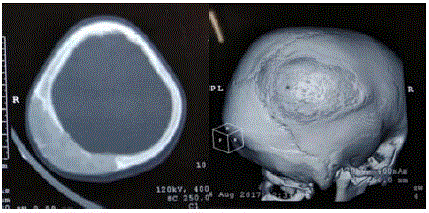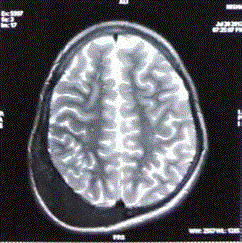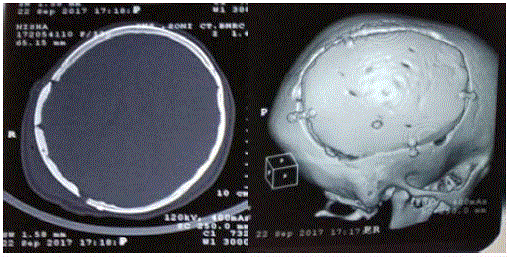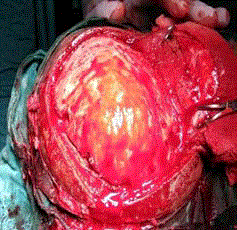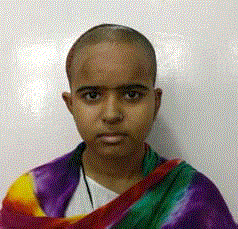Case Report
Single Stage Cranioplasty Following Calvarial Tumor Resection Using Anatomised Three Dimentional Printed Model
S.K. Jain*
Department of Neurosurgery, Jaipur - 302 003, Rajasthan, India
*Corresponding author: S.K. Jain, Department of Neurosurgery, Jaipur - 302 003, Rajasthan, India
Published: 16 Jan, 2018
Cite this article as: Jain SK. Single Stage Cranioplasty
Following Calvarial Tumor Resection
Using Anatomised Three Dimentional
Printed Model. Clin Surg. 2018; 3: 1862.
Abstract
In prehistoric era archeological evidences suggest that cranial defect (Trephination) reconstruction
was done with gold, silver and shells. The next advancement was the use of bone grafts in late
19th century. In 20th century alternatives of bone graft, metals and plastics were used. Cranial
reconstruction can be done by auto grafts, allograft, distinct biomaterials, and even osteoinductive
growth factors. Polymethylmethacrylate (PMMA) is one of the most popular materials used for
cranioplasty. But attainment of desired shape, size and cosmesis is difficult. This problem can be
solved with the help of 3 dimentional printing technology, using prefabricated model (template)
to prepare implant preoperatively. In this case report, we developed a computer-generated model
(template) using the 3D Object printer. A mould (template) was created and it was used intraoperatively
to produce a PMMA-alloplastic cranial implant that was well fitted into the anatomical
defect. A well-fitted implant improves cosmetic outcome, self confidence and reduces the risk of
implant movement or extrusion. 3D printed model helps us to provide exact dimensions of the bony
defect along with good cosmesis, accuracy and strength of the anatomic replacement.
Keywords: Skull bone tumor; single stage Calvarial reconstruction; 3D model (template);
Polymethylmethacrylate
Introduction
Cranioplasty is the surgical repair of acquired or congenital defects of cranium [1]. Archeological evidences suggest that in pre historical era, cranial defect reconstruction was done with gold, silver and shells. Later it was followed by the use of bone grafts, metal and plastics [2,3]. Apart from metals like titanium, Polymethylmethacrylate (PMMA) is the latest material being used for cranioplasty. It was first utilized in 1940 and can be moulded intraoperatively by hands or using 3D printed models into the shape of a cranial defect [4]. Prefabricated Titanium implants have been successfully solving this purpose of cranioplasty, but are quite expensive especially in developing countries. In modern era, for getting desired shape, size and better cosmetic results, the use of Three-Dimensional (3D) printing technology has come into existence. With evolution of this technology; its application has expanded, to various aspects of surgeries especially craniofacial. Implants can be prepared intraoperatively by PMMA, with the help of 3D moulds which are generated using 3D printer technology. These are quite costeffective and a good alternative to costly titanium implants. In our case, we developed a computer-generated model (template) using the 3D Object printer. A mould (template) was created and it was used intra-operatively to produce a PMMA-alloplastic cranial implant that was well fitted into the anatomical defect. A well-fitted implant improves cosmetic outcome, self confidence and reduces the risk of implant movement or extrusion. The 3D printed model helps us to provide exact dimensions of the bony defect along with good cosmesis, accuracy and strength of the anatomic replacement.
Case Presentation
A 13 years female presented with complaints of painless, slowly progressive, bony hard swelling
in the right parietal region since one year. On examination swelling was fixed, bony hard, immobile
with ill defined margins, non pulsatile and non tender. It was approximatey 5x5cm in size. CT brain
with 3D reconstruction suggested of osteolytic bony tumour reaching to the midline (Figure 1).
MRI brain was suggestive of no dural or any parenchymal invasion (Figure 2). Patient was planned
for single stage excision of calvarial mass and reconstruction. Pre operatively a 3D model (template) was constructed using 3D CT brain. 3D printing technology used to manufacture the model (template) was “Selective Laser Sintering
(SLS)”. The material used was nylon pa 2200 which is biocompatible
and autoclavable. Intra operatively the area of resection was outlined
with the help of previously prepared template, but the area of
resection was crossing midline. To prevent sinus injury craniectomy
was done leaving some tumor tissue in midline which was later
removed via bone nebular. Tumour free margin was achieved and
it was reassessed with the help of template (Figure 3). The calvarial
graft was prepared using poly methyl methacrylate (bone cement).
This alloplastic graft was moulded in exact dimensions and evenly
distributed thickness by using previously prepared 3D printed model.
The graft was re analysed and margins were drilled to make them non
traumatic. It was applied on the cranial defect and fixed with the help
of titanium miniplates (Figure 4). Exact shape and contour of parietal
bone was achieved as that of the opposite side (Figure 5).
Figure 1
Figure 2
Figure 3
Figure 4
Figure 5
Discussion
The history of cranial reconstruction goes back to 3000 BC, where
archeological evidences suggest that head trephination repair was
done with the use of metals, shells, and gourds. In subsequent years
the practice of cranioplasty was done by using moistened linen, which
was applied over wounds and regular dressings were performed to
promote wound granulation [2,3]. In 1505, the Ottoman surgeon
Ibrahim bin Abdullah published the first case of cranioplasty in his
book, “Wonders of Surgeons” and he used canine-derived xenografts.
In 1668, a Dutch surgeon Job Janszoon van Meekeren reported the
first successful bone graft cranioplasty [5,6]. Autogenous bone grafts
are preferred over alloplastic materials to reconstruct the cranial
defects. Alloplastic material is required when autogenous bone is not
available as in calvarial tumour resections, bone infections or bone
discarded during craniectomies. Now a day’s PMMA and titanium
are most widely used alloplastic materials. Preparation of implants
can be done in two ways - by hands and by computer generated 3D
models [7,8]. Hand fabrication is cheaper and less time consuming
technique but desired outcome with respect to shape and size is
difficult. The 3D printing technology helps us to prepare prefabricated
implants or models to mould grafts intraoperatively. This method
has become immensely popular as it does not require original
bone flap and has produced superior fitting and cosmetic results
[9]. 3D printing technology is an evolving branch and its clinical
application is growing rapidly. The convenience and affordability of
this technology have spurred its adoption in variety of medical fields,
especially in planning complex craniofacial reconstructions [10,11].
The procedure for the fabrication of medical models (templates)
consists of multiple steps:
1. Acquisition of high-quality volumetric 3D image data of
the anatomical structure to be modeled.
2. 3D image processing to extract the region of interest from
the surrounding tissues.
3. Mathematical surface modeling of the anatomic surfaces.
4. Formatting of data for rapid prototyping.
5. Model building.
6. Quality assurance of the model and its dimensional accuracy [12-15].
Pre operatively computer generated models are very helpful in
management of large full thickness defects of cranium. These large
defects preclude the use of autogenous tissue for reconstruction and
also pose difficulty in shaping the bone graft. In these cases computer
generated models allow pre operative analysis and perfect shaping of
the alloplastic implants. Advantages include less operative time and
simplification of procedure.
Conclusion
Hand-fabrication of PMMA prostheses is an excellent alternative but it does not provide desired cosmetic results especially in large cranial defects such as following decompressive craniectomy or after excision of calvarial tumors. Prefabricated Titanium implants that are generated with the help of 3D printing technology are costlier. To solve this problem, PMMA mould was prepared intraoperatively using model or template developed preoperatively by same technology. It provides same cosmetic results and is quite cheaper. Hence this technique has proven to be safe and has yielded excellent results with cost effectiveness.
References
- Dujovny M, Aviles A, Agner C, Fernandez P, Charbel FT. Cranioplasty: Cosmetic or therapeutic? Surg Neurol. 1997;47:238-41.
- Andrushko VA, Verano JW. Prehistoric trepanation in the Cuzco region of Peru: a view into an ancient Andean practice. Am J Phys Anthropol. 2008;137:4-13.
- Eftekhar B, Dadmehr M, Ghodsi M, ParsaPour A, Ketabchi E. Cranial trephination in ancient Iran. Case illustration. J Neurosurg. 2007;106(1):70.
- Gordon CR, Fisher M, Liauw J, Lina I, Puvanesarajah V, Susarla S, et al. "Multidisciplinary Approach for Improved Outcomes in Secondary Cranial Reconstruction: Introducing the Pericranial-onlay Cranioplasty Technique". Neurosurgery. 2014;10(2):179-90.
- Aciduman A, Belen D. The earliest document regarding the history of cranioplasty from the Ottoman era. Surg Neurol. 2007;68:349-53.
- bin Abdullah I: Alâim-i Cerrâhin. Istanbul. Süleymaniye Library, Hekimoglu Ali Pasa, number: 568, 911 AH/1505: folios 1b,
- Marchac D, Greensmith A. Long-term experience with methylmethacrylate cranioplasty in craniofacial surgery. J Plast Reconstr Aesthet Surg. 2008;61:744-53.
- Sahoo N, Roy ID, Desai AP, Gupta V. Comparative evaluation of autogenous calvarial bone graft and alloplastic materials for secondary reconstruction of cranial defects. J Craniofac Surg. 2010;21:79-82.
- Gasparini G, Boniello R, Moro A, Tamburrini G, Di Rocco C, Pelo S. Cranial reshaping using methyl methacrylate: Technical note. J Craniofac Surg. 2009;20:184-90.
- Winder J, Bibb R. Medical rapid prototyping technologies: state of the art and current limitations for application in oral and maxillofacial surgery. J Oral Maxillofac Surg. 2005;63:1006-15.
- Epply BL, Kilgo M, Coleman III JJ. Craniofacial reconstruction with computer generated patient – matched HTR implants, Indication, Technique, and long term results. 2002;109(3):864-71.
- Dumbrigue HB, Arcuri MR, LaVelle WE, Ceynar KJ. Fabrication procedure for cranial prostheses. J Prosthet Dent. 1998;79:229-31.
- Jordan RD, White JT, Schupper N. Technique for cranioplasty prosthesis fabrication. J Prosthet Dent. 1978;40:230-3.
- Chrzan R, Urbanik A, Karbowski K, Moskala M, Polak J, Pyrich M. Cranioplasty prosthesis manufacturing based on reverse engineering technology. Med Sci Monit. 2012;18:MT1-6.
- Hoy MB. 3D printing: making things at the library. Med Ref Serv Q. 2013;32:94-9.

